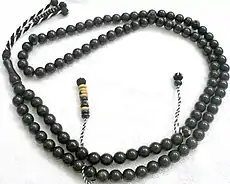Dervish
Dervish or Darvesh or Darwīsh (from Persian: درویش, Darvīsh[1]) in Islam can refer broadly to members of a Sufi fraternity (tariqah),[2][3] or more narrowly to a religious mendicant, who chose or accepted material poverty.[3][4] The latter usage is found particularly in Persian and Turkish (Derviş), corresponding to the Arabic term faqir.[3] Their focus is on the universal values of love and service, deserting the illusions of ego to reach God. In most Sufi orders, a dervish is known to practice dhikr through physical exertions or religious practices to attain the ecstatic trance to reach God.[5] Their most common practice is Sama, which is associated with the 13th-century mystic Rumi.

_001.jpg.webp)
In folklore, dervishes are often credited with the ability to perform miracles and described with supernatural powers.[6]
Etymology
| Part of a series on Islam Sufism |
|---|
|
|
| Part of a series on |
| Sunni Islam |
|---|
 |
|
|
The Persian word darvīsh (درویش) is of ancient origin and descends from a Proto-Iranian word that appears in Avestan as drigu-, "needy, mendicant", via Middle Persian driyosh.[4] It has the same meaning as Fakir, meaning people whose contingency and utter dependence upon God is manifest in everything they do and every breath they take.
Religious practice
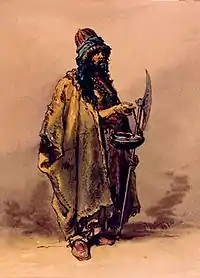
Dervishes try to approach God by virtues and individual experience, rather than by religious scholarship.[7] Many dervishes are mendicant ascetics who have taken a vow of poverty, unlike mullahs. The main reason they beg is to learn humility, but dervishes are prohibited to beg for their own good. They have to give the collected money to other poor people. Others work in common professions; Egyptian Qadiriyya – known in Turkey as Kadiri – are fishermen, for example.
Some classical writers indicate that the poverty of the dervish is not merely economic. Saadi, for instance, who himself travelled widely as a dervish, and wrote extensively about them, says in his Gulistan:
Of what avail is frock, or rosary,
Or clouted garment? Keep thyself but free
From evil deeds, it will not need for thee
To wear the cap of felt: a darwesh beIn heart, and wear the cap of Tartary.[8]
Rumi writes in Book 1 of his Masnavi:[9]
Water that's poured inside will sink the boat
While water underneath keeps it afloat.
Driving wealth from his heart to keep it pure
King Solomon preferred the title 'Poor':
That sealed jar in the stormy sea out there
Floats on the waves because it's full of air,
When you've the air of dervishood insideYou'll float above the world and there abide...
Whirling dervishes
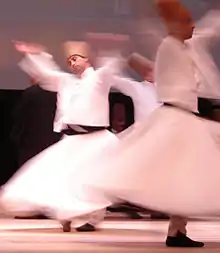
The whirling dance or Sufi whirling that is proverbially associated with dervishes is best known in the West by the practices (performances) of the Mevlevi order in Turkey, and is part of a formal ceremony known as the Sama. It is, however, also practiced by other orders. The Sama is only one of the many Sufi ceremonies performed to try to reach religious ecstasy (majdhb, fana). The name Mevlevi comes from the Persian poet Rumi, who was a dervish himself. This practice, though not intended as entertainment, has become a tourist attraction in Turkey.[10][11][12]
Orders

There are various orders of dervishes, almost all of which trace their origins from various Muslim saints and teachers, especially Imam Ali. Various orders and suborders have appeared and disappeared over the centuries. Dervishes spread into North Africa, the Horn of Africa, Turkey, the Balkans, the Caucasus, Iran, Pakistan, India, Afghanistan, and Tajikistan.
Other dervish groups include the Bektashis, who are connected to the janissaries, and the Senussi, who are rather orthodox in their beliefs. Other fraternities and subgroups chant verses of the Qur'an, play drums or whirl in groups, all according to their specific traditions. They practice meditation, as is the case with most of the Sufi orders in South Asia, many of whom owe allegiance to, or were influenced by, the Chishti order. Each fraternity uses its own garb and methods of acceptance and initiation, some of which may be rather severe. The form of Sufi dervishism practised during the 17th century was centered upon esotericism, patience and pacifism.[13]
Somali Dervish movement
The Dervish movement was an early 20th-century Somali Sunni Islamic state that was established by Mohammed Abdullah Hassan, a religious leader who gathered Somali soldiers from across the Horn of Africa and united them into a loyal army known as the Dervishes. This Dervish army enabled Hassan to carve out a powerful state through conquest of lands claimed by the Somali Sultans, the Ethiopians and the European powers. The Dervish movement acquired renown in the Islamic and Western worlds due to its resistance against Britain and Italy. The Dervish movement successfully repulsed British-led Somali and Ethiopian forces four times and forced them to retreat to the coastal region.[14] The polity also maintained relations with other authorities, receiving support from the Ottoman and German empires. The Turks also named Hassan Emir of the Somali nation,[15] and the Germans promised to officially recognize any territories the Dervishes were to acquire.[16] The Dervish movement was finally defeated by the British in 1920.
Other historical uses
Mahdists
Various western historical writers have sometimes used the term dervish rather loosely, linking it to, among other things, the Mahdist uprising in Sudan and other rebellions against colonial powers. In such cases, the term "dervishes" may have been used as a generic (and often pejorative) term for the opposing Islamic entity and all members of its military, political and religious institutions, including persons who would not be considered "dervishes" in the strict sense.
During the Mahdist war, Muḥammad Aḥmad al-Mahdī decreed that all those who came to join him should be styled anṣār, after the Prophet’s earliest followers. He forbade the use of the term ‘dervish’ to describe his followers. Despite this, British soldiers and anti-Mahdist propagandists continued to use the term in relation to the anṣār. While propagandists used the term to denigrate the followers of the Mahdī, it was also used with a sense of admiration in accounts by British soldiers which describe the fearlessness and bravery of the lightly-armed 'dervishes'. [17] Thus, the word has become closely associated with the anṣār and is often used inaccurately in relation to the Mahdi’s followers, even today.
For example, a contemporary British drawing of the fighting in Sudan was entitled "The defeat of the dervishes at Toski" (see History of Sudan (1884–1898)#British response).
Gallery
 A Qajar-era Persian dervish, seen here from an 1873 depiction of Tehran's Grand Bazaar.
A Qajar-era Persian dervish, seen here from an 1873 depiction of Tehran's Grand Bazaar.-begging_dervis.png.webp)
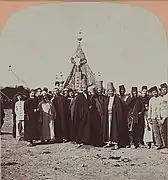 Dervishes photographed by William H. Rau near Damascus, circa 1903
Dervishes photographed by William H. Rau near Damascus, circa 1903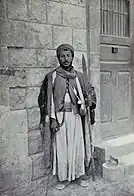 A Palestinian Dervish in 1913
A Palestinian Dervish in 1913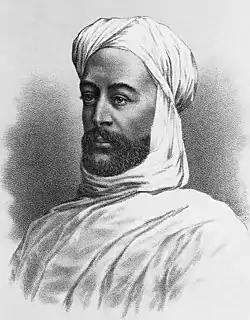 Muhammad Ahmad al-Mahdi, leader of the Sudanese Dervishes
Muhammad Ahmad al-Mahdi, leader of the Sudanese Dervishes Sufi kashkuls were often made from a coco de mer which ordinary beggars would have difficulty to find
Sufi kashkuls were often made from a coco de mer which ordinary beggars would have difficulty to find Kashkul, or Beggar’s Bowl, with Portrait of Dervishes and a Mounted Falconer, A.H. 1280. Brooklyn Museum.
Kashkul, or Beggar’s Bowl, with Portrait of Dervishes and a Mounted Falconer, A.H. 1280. Brooklyn Museum. A Gathering of Dervishes in the Mughal Empire
A Gathering of Dervishes in the Mughal Empire A Family of Dervishes, possibly by Antoin Sevruguin (between 1876 and 1925)
A Family of Dervishes, possibly by Antoin Sevruguin (between 1876 and 1925)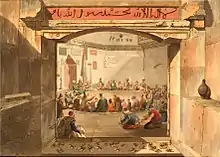 The dance of the dervishes, Athens, Ottoman Greece, by Dodwell
The dance of the dervishes, Athens, Ottoman Greece, by Dodwell The dance of the dervishes, Athens
The dance of the dervishes, Athens.jpg.webp) Sufi dervishes in Omdurman, Sudan
Sufi dervishes in Omdurman, Sudan
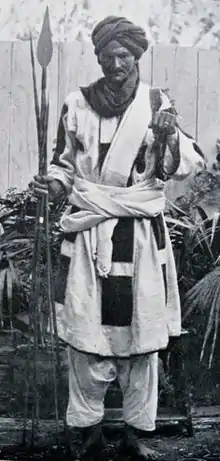 A Mahdist Dervish from Sudan (1899)
A Mahdist Dervish from Sudan (1899)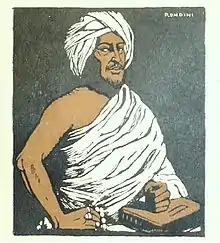 Sayyid Mohammed Abdullah Hassan, leader of the Somali Dervish movement
Sayyid Mohammed Abdullah Hassan, leader of the Somali Dervish movement
See also
- Derviş, a variant of the spelling
- Fakir
- Qalandariyya
- Warsangeli Daraawiish
- The Tale of the Four Dervishes Qissa Chahar Dervish
- Death and the Dervish, a novel by Yugoslav writer Meša Selimović (published in 1966)
- 2018 Dervish protests
- Noor Ali Tabandeh
- Seyed Mostafa Azmayesh
- Kasra Nouri
External links
| Wikimedia Commons has media related to Dervishes. |
| Wikisource has the text of the 1905 New International Encyclopedia article "Dervish". |
References
- "Dervish - Definition and More from the FreeMerriam - Webster Dictionary". M-w.com. Retrieved 2012-02-19.
- Dervish, Encyclopaedia Britannica,
Dervish, Arabic darwīsh, any member of a Ṣūfī (Muslim mystic) fraternity, or tariqa.
- MacDonald, D.B. (2012). "Darwīs̲h̲". In P. Bearman; Th. Bianquis; C.E. Bosworth; E. van Donzel; W.P. Heinrichs (eds.). Encyclopaedia of Islam (2nd ed.). Brill. doi:10.1163/1573-3912_islam_SIM_1731.
- Mansour Shaki, Hamid Algar (2011). "DARVĪŠ". Encyclopædia Iranica. Iranicaonline.org.CS1 maint: uses authors parameter (link)
- "Encyclopædia Britannica". britannica.com. Retrieved 2015-07-10.
- Frederick William Hasluck Christianity and Islam Under the Sultans, Band 1 Clarendon Press 1929 p. 281
- JENS PETER LAUT Vielfalt türkischer Religionen 1996 p. 29 (German)
- chapter 2 story 16: "The Gulistān; or, Rose-garden, of Shek̲h̲ Muslihu'd-dīn Sādī of Shīrāz, translated for the first time into prose and verse, with an introductory preface, and a life of the author, from the Ātish Kadah" a story later adapted by La Fontaine for his tale 'Le songe d'un habitant du Mogol'
- The Masnavi: Book One, translated by Jawid Mojaddedi, Oxford World's Classics Series, Oxford University Press, 2004. ISBN 978-0-19-955231-3, p63.
- Koentges, Chris (2012-06-29). "13 Things The Whirling Dervishes Can Teach You About Spinning Until You're Dizzy Enough To Puke". The Very Ethnic Project.
- B. Ghafurov, "Todjikon", 2 vols., Dushanbe 1983-5
- Rumi Britannica.com
- Erdoan, Nezih. "Star director as symptom: reflections on the reception of Fatih Akn in the Turkish media." New Cinemas: Journal of Contemporary Film 7.1 (2009): 27-38.
- Encyclopedia of African history - Page 1406
- I.M. Lewis, The modern history of Somaliland: from nation to state, (Weidenfeld & Nicolson: 1965), p. 78
- Thomas P. Ofcansky, Historical dictionary of Ethiopia, (The Scarecrow Press, Inc.: 2004), p.405
- Nusairi, Osman and Nicoll, Fergus A note on the term ansar. Making African Connections. Retrieved December 19, 2020.

